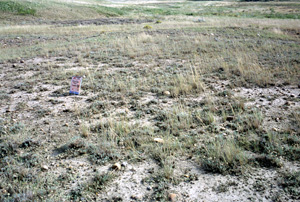Community Field Guide
Scientific Name:
Eriogonum pauciflorum - Gutierrezia sarothrae Badlands Sparse Vegetation
Common Name:
Wild buckwheat- snakeweed Badlands Sparse Vegetation
Community Description
Summary:
The few-flowered wild buckwheat - broom snakeweed Badlands sparse vegetation represents an outcrop or scabland feature of the northern Great Plains in Montana, North Dakota and South Dakota. It occurs on unconsolidated or poorly consolidated sedimentary formations that are easily eroded, including siltstones, mudstones, and shales (particularly acid shales). Slopes that become stabilized revegetate to grassland with succession. This badlands plant association type rarely exceeds 10% vegetative cover and is often less than 5% hence it is technically placed in a sparse vegetation classification category rather than a grassland plant association. On level terrain, the vegetation is relatively evenly distributed, but on steeper slopes and cliffs the vegetation may grow in patches and in rows or seams. Plant species that are nearly always present include Eriogonum pauciflorum (few-flowered buckwheat), Gutierrezia sarothrae (broom snakeweed), Opuntia polyacantha (plains pricklypear), Chrysothamnus nauseosus (common rabbitbrush), Atriplex argentea (silverscale), a cryptantha (Cryptantha thyrsifolia), a characteristic plant at least in South Dakota), and the forb Grindelia squarrosa (gumweed). In the study area this community is restricted to the most exposed and rugged breaks of the Frenchman, Rock, Crow and Bitter Creek drainages and major tributaries cutting into bedrock and also occurs on low gradient outwash fans within the same drainages.
Environment:
In Badlands National Park, South Dakota, this type is typically found on silty/ Sandy outwash fans newly deposited by eroding badlands formations. These formations include Cretaceous Pierre shale, Oligocene Brule siltstone and Chadron clayey mudstone and shale, and Miocene Arickaree sandstone. Soils are undeveloped, poor, loose, and easily eroded. The topography is typically flat, and stands occur on erosional outwash fans. One stand, comprised of four-wing saltbush, occupies a large badlands flat and erosion fan (Von Loh et al. 1999).
Vegetation:
This badlands community type rarely exceeds 10% vegetative cover and is often less than 5%. On level terrain, the vegetation is relatively evenly distributed, but on steeper slopes and cliffs the vegetation may grow in patches and in rows or seams. In Badlands National Park, plant species that are nearly always present include the Dwarf Shrubs Eriogonum pauciflorum, Gutierrezia sarothrae, Opuntia polyacantha, Atriplex argentea, and Cryptantha thyrsiflora, and the forb Grindelia squarrosa. Atriplex canescens dwarf Shrubs were observed throughout the type, but were typically short- Statured and scattered in distribution (Von Loh et al. 1999).
Range:
This badlands type is found in the northwestern Great Plains in badlands topography.
Global Rank: G4G5 State Rank: S?
Global Rank Comments:
In Badlands National Park, South Dakota, this community type occupies badland formations, which cover approximately 45% of the park (Von Loh et al. 1999). It is probably found in other badlands habitats in the Northern Great Plains.
Community References
Identifier:
CEGL005270
Author:
D. Faber-Langendoen, MCS, mod. S.V. Cooper & C. Jean, MTNHP
Citations:
Von Loh et al. 1999, Cooper et al. 2001, Vanderhorst et al. 1998
View Detailed Citation Information | New Community Search | NatureServe Explorer Community Information
This information is from the:
Montana Natural Heritage Program
Montana State Library--Natural Resource Information System
1515 East Sixth Ave., Helena, MT 59620-1800
406 444-3989
mtnhp.org
mtnhp@mt.gov






